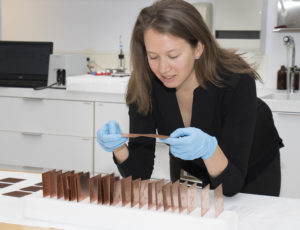7th March 2017 Science Innovation USA
From STEM to STEAM: Science and Art Go Hand-in-Hand
A Conversation with Rosie Grayburn, Postdoctoral Fellow at the Getty Conservation Institute
In recognition of International Women’s Day, I interviewed a very inspiring female scientist working here in Los Angeles. Rosie’s career illustrates the strong science ties between the US and the UK, as she originally hails from England.
Can you tell me a little bit about your work?
I am a conservation scientist, specialising in corrosion and corrosion control of historic metals. I am currently working with sculpture conservators to try to improve our understanding of treatments for outdoor bronze statuary while also considering analytical techniques for extracting depth-resolved information from coatings. What I love about treatment studies in conservation science is that decision making goes far beyond just the material considerations: aesthetics, perception and artist intent play a very significant role too. It’s 100% interdisciplinary!
How did you end up in your current field?
In high school I had a chance encounter with Cima’s painting of The Incredulity of Saint Thomas. The work was presented in an A-level chemistry textbook as an application for analytical chemistry, which really opened my eyes to the practical application of science to art. This motivated me to study chemistry at Imperial College London, which is a science and engineering university in the heart of London’s museum district, where I could immerse myself in both fundamental science and art.

What are the challenges you face as a woman in this field?
Being now removed from academia, I do not feel any particular challenges as a woman. In art conservation the gender balance is often skewed the opposite way to the physical sciences, which presents opposite but equal challenges to improve diversity.
Is there any advice you would give to young female scientists?
Find a mentor who is established in your field of interest. Mentors have been invaluable to me as a source of advice and guidance throughout my career. Normally over a good cup of tea, they have helped me come to important decisions at career crossroads and given me advice on managing my work-life balance. I hope one day soon I will be able to do the same for young scientists.
Is there any advice you would give to someone who is interested in working in your area of research?
There is no clear path to becoming a conservation scientist and almost everyone I know in the field has come into it via a different route. However, having a higher degree in science is paramount. There are opportunities for postdoctoral fellowships and internships in museums around the world for those coming from different scientific disciplines.
Dr Rosie Grayburn is from Macclesfield, Cheshire. She is currently a postdoctoral fellow at the Getty Conservation Institute in Los Angeles. From June 2017 she will be Associate Scientist at Winterthur Museum, DE.
